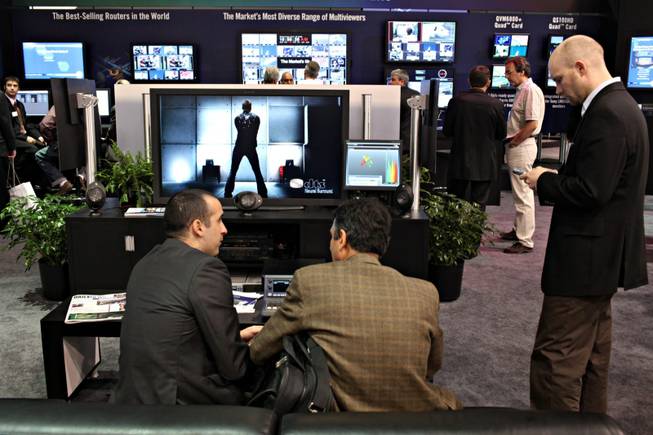
Conference attendees check out the latest technologies at the Harris booth at the National Association of Broadcasters show at the Las Vegas Convention Center on April 22.
Friday, May 1, 2009 | 2 a.m.
Reader poll
Sun Archives
- Twitter helping to get the word out (4-30-2009)
- Outraged or dull, politicians atwitter (3-18-2009)
One theme that resonated throughout the National Association of Broadcasters show at the Las Vegas Convention Center last week is that the entire industry is in the midst of an evolution. Some might even call it a revolution.
The definition of what constitutes a broadcast or a network, for example, is much different from it was just a few years ago.
This was never more evident than at a recent performance of Criss Angel’s “Believe,” the Cirque du Soleil show at the Luxor.
Celebrity blogger Perez Hilton used the social messaging network Twitter to “tweet” (relay) a scathing review of the in-progress performance to his followers. The comments were subsequently relayed to Angel in time for him to respond with a barrage of insults directed at Hilton as the show closed.
This type of instantaneous “networking” may just be the tip of the iceberg, according to NAB speakers.
In a session entitled “Cool Gadgets, Hot Content,” Brian Cooley of CENT Networks and Peggy Miles of Intervox Communications explained that technological advances have made it possible for almost anyone to create a network.
Social networks such as Twitter, Facebook and YouTube provide the platform, and technology giants such as Harris Communications develop increasingly affordable equipment to relay the message.
Items such as hand-held recorders that can transfer messages directly to social networking sites will soon be available to the public for a few hundred dollars.
“There is already talk that Twitter may become the next network,” Miles said.
That may be a hard concept to grasp for people who still think of a network as television stations broadcasting sitcoms, but the reality is that people now crave instantaneous information and are seeking it from alternate sources.
“It’s definitely a younger generation, a more technically savvy generation, but they are influences on the edge,” Cooley said. “When they are older and have a lot more disposable income they will still have this in them and say, ‘I can get TV in a lot of places, not just the traditional outlets.’ It’s important to realize that there is a vanguard of people who are thinking this way already.”
The challenge is to broaden broadband capability to accommodate all of these new uses.
Even the automobile, which radio has traditionally dominated, will soon be besieged with a plethora of options. We’re not just talking about a dashboard device for directions or a television screen in the back seat that shows movies to keep the kids occupied.
The capability to transmit real-time traffic, weather and television programs on demand already exists and will soon be available to the masses.
“The car tends to be owned by radio broadcast and it’s just a very restrictive environment,” Cooley said. “That’s changing with connectivity.”
Blaupunkt has developed car audio head units that are the first in the market to have integrated Internet audio streaming. These devices will change the game because they do more than just pick up broadcast radio signals. By using a data connection on a smart phone, the Bluetooth becomes a streaming device for the unit. There are no complicated connectivity issues and no account to sign up for.
The units will cost about $400, so almost anyone will be able to afford them.
Even traditional radio transmissions might soon begin to look more like television. Radio programmers can already transmit images if they so choose and visuals that show polling information, animated images and scrolling messages, similar to those at the bottom of a television screen, could soon be common.
It’s one thing to be able to tune to a station that gives frequent traffic or news updates, quite another to get traffic information on a specific route or immediately access a breaking news event with a keyword while traveling.
ISet, a Korean-based company, has teamed with Harris Communications to deliver hand-held devices with these capabilities and more.
Initially promoted in the United States as a real-time traffic content and disaster alert system provider, the device can offer a number of other services.
“We are promoting the traffic and disaster alert capabilities, because that will be the easiest way to initially connect to consumers in this market,” said Chris Lee, manager of Global Marketing and sales for iSet.
At some point the providers will add real-time movies, sports content, stock information and television programming, which will all be available on demand through a wireless network on a hand-held device.
Ultimately the goal of these providers is to allow the end users (us) to be able to determine not just what type of programming they want to access, but the specific information they want, when and where they want it.
Mark Hansel covers retail and marketing for In Business Las Vegas and its sister publication, the Las Vegas Sun. He can be reached at 259-4069 or at [email protected].


Join the Discussion:
Check this out for a full explanation of our conversion to the LiveFyre commenting system and instructions on how to sign up for an account.
Full comments policy